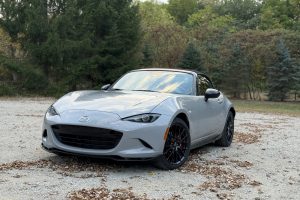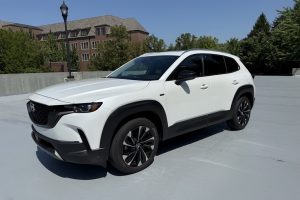When Mazda pulled the plug on the RX-8 back in 2012 it was more than just the end of a production for a slow-selling sports car, it marked the end of the line for the rotary engine. But the once promising technology, more promising known as the Wankel engine, may be ready to make a comeback. But it will function in a distinctly different form than it did in the past, according to Mazda’s CEO. More from Headlight.News.
The Iconic SP concept uses a battery-electric drivetrain backed up by a rotary engine range-extender.
Few automakers have been more closely identified with a specific powertrain than Mazda which once made the Wankel rotary engine as much a part of the brand as its long-running “Zoom-Zoom” tagline.
The rotary vanished from the U.S. market in 2012 when Mazda ended production of the RX-8 sports car – but the automaker has been looking for ways to bring it back ever since. That has proved to be difficult as the Wankel engine, as it’s formally known, has some challenges to overcome, notably high emissions levels.
But the automaker is now using a scaled-down version of the rotary engine in Europe, serving as a range-extender for the little MX-30 battery-electric vehicle. And there’s a growing likelihood that a more advanced version will make it back to the U.S. in the not-too-distant future serving a similar role in a production version of the widely acclaimed Mazda Iconic SP concept vehicle.
What’s a Wankel
Conceived by German engineer Felix Wankel, back in the 1920s, the Wankel engine has no pistons or cylinders. Instead, it has a triangular-shaped rotor that turns in a sort of figure-eight pattern inside a housing as fuel is injected and then ignited.
There are a number of advantages over conventional piston engine designs. Rotary engines develop significant horsepower from a very small package. There are far fewer moving parts. And they run much more smoothly. On the downside, they produce emissions that can be difficult to clean up. And the seals at the tips of the rotor are prone to wear that can lead to catastrophic failure.
A number of automakers initially planned to introduce rotary engines, including American Motors and General Motors, though only two actually brought the technology to market. That briefly included NSU, a forerunner of today’s Audi, and Mazda.
Mazda bets big
The Japanese automaker went all-in on the rotary engine, starting with the Cosmo sports car introduced in 1967. It followed with a number of other models, including the RX-2 and RX-3 sedans and the RX-7 sports car.
Early on, before Mazda found a way to prevent rotor seal failures, vehicles like the RX-2 suffered high breakdown rates that nearly led to the company’s failure back in the mid-1970s. But once resolved, the advantages helped make the RX-7 one of the more popular Japanese sports cars.
The automaker followed up with the quirky RX-8 before finally ending production in 2012, in part due to declining sales but the rotary’s problem with emissions “was the reason we discontinued RX-8 in 2012,” Global CEO Masahiro Moro explained during a recent interview.
More Mazda News
- Mazda Likely to Spread Tariff Pain, Says CFO
- First Drive: Mazda CX-70 PHEV
- Mazda Confirms Next CX-5 Will Get Hybrid
Return of the rotary

The Mazda MX 30 didn’t last long in the U.S. due to range of barely 100 miles. It’s gotten a second chance in Europe thanks to a Wankel-powered range-extender.
Since then, Mazda has made several attempts to bring back the rotary, though it appeared to be giving up by the beginning of this decade, shifting attention to its SkyActiv internal combustion technology. But there are reasons why it is taking another look.
There’s the little MX-30 EV. It failed to gain traction in the U.S. market due to its limited range. To overcome that hurdle in the European package, Mazda stuffed a single-rotor Wankel under the EV’s hood, using it not to directly power the wheels but to serve as a generator to recharge the MX-30’s batteries when they start to run down.
Now, Mazda is looking at having a larger, two-rotor version serve a similar role with the Iconic SP first shown in Tokyo at the Japan Mobility Show in autumn 2023, Moreo told Headlight.News during a meeting at the automaker’s headquarters in Hiroshima, Japan.
An icon for the Iconic SP
From the start, Iconic was envisioned to be battery-powered, though Mazda didn’t want to repeat the mistakes of the MX-30 which simply didn’t have room for enough batteries to deliver competitive range. That meant it would also need to go with a range-extender design, using an internal combustion engine to recharge the batteries as they began running down. There was no room under the sports car’s hood to squeeze in a piston engine, however.
So, with the show car generating “big support from many customers and journalists,” recalled Moro, “I decided to reopen the rotary development department. They are working like hell right now.”
As with earlier versions of the rotary, the big challenge remains emissions, though Moro said, “We are making great progress. We are very close” to meeting the tough Euro-4 standards, a target that would also permit Mazda to bring the Wankel back to the U.S.
One reason is that in a range-extender application, a Wankel would operate in a very narrow, steady RPM range, rather than revving up and down, making it easier to control emissions.
Like many new EVs, Mazda designers opted for a minimalist cabin layout for the Iconic SP concept. The automaker wants to hold close to the show car’s design if it goes into production.
What next
It would also be more fuel efficient than if it were used as a vehicle’s primary source of power, as had been done in past applications. So, Mazda officials believe that a rotary range-extender would be able to give a production version of the Iconic SP a combined range of as much as 1,000 km (about 625 miles) before needing to fuel up or plug into an EV charger.
As for timing, Moro acknowledged Mazda isn’t quite ready to relaunch the Wankel. The two-rotor version is still in development. But, he added, “If the two-rotor proves we (can) comply with emissions, that is going to be a magic moment for us to decide on a target date.”
While he said “We leave it open” for now, but my personal expectation is to have that sometime…2028 to 2030. I don’t mind if that is pushed back. I want it as soon as possible.”







0 Comments